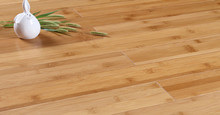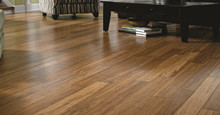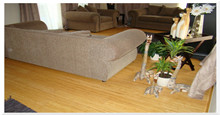Before looking at Treffert’s role, it’s worth briefly revisiting the substrate itself. Bamboo is a grass, not a hardwood, which gives it a few special characteristics that influence finishing:
High silica content: Bamboo often contains more silica than typical hardwoods. Silica behaves abrasively during sanding and can affect adhesion if the surface preparation isn’t controlled.
Density and hardness variation: Strand-woven bamboo, horizontal and vertical constructions all differ in density. Strand-woven in particular can reach very high Janka hardness, which is an advantage for dent resistance but increases internal stresses during curing.
Different fiber structure: Long, aligned fibers and the use of adhesive in strand-woven products create more interfaces. Coating must bridge these micro-variations without cracking.
Because of these factors, bamboo behaves differently from oak or maple on the coating line. A coating system that works well on classic parquet can show unexpected adhesion issues, gloss instability or premature micro-cracking on bamboo if it isn’t adapted properly. This is where specialized systems such as Treffert have made an impact.
The Treffert Coating System: More Than Just a Top Layer
Treffert is best known in the flooring industry for its multi-layer UV-curable coating systems. When used on bamboo, it usually consists of several distinct layers, each with a specific function:
Primer / sealer layer
Promotes adhesion to the bamboo or to the adhesive-rich surface in strand-woven products.
Helps to equalize absorption, which is important on mixed, high-density substrates.
Reduces the risk of side-bonding in tongue-and-groove joints by controlling penetration.
Intermediate build coats
Provide film thickness, flexibility and impact resistance.
Level out minor surface irregularities from sanding or pressing.
Act as a buffer between the rigid top coat and the more elastic bamboo.
Top coat(s) with abrasion and scratch resistance additives
Contain special hard particles and cross-linking agents to resist micro-scratches.
Define the gloss level (from ultra-matte to high gloss).
Provide the main protective barrier against household chemicals and staining.
This layered approach means that scratch resistance is not just a single-parameter property. It’s a balance among hardness, flexibility, adhesion and surface energy. Treffert systems are designed to find that balance specifically for flooring applications.
How Treffert Coating Improves Scratch Resistance
Scratches on bamboo flooring come in two main forms:
Micro-scratches: Fine, shallow lines that scatter light and create dull areas, especially noticeable on darker or high-gloss finishes.
Macro-scratches: Deeper grooves caused by sharp objects, grit under shoes, furniture movement or pets.
Treffert coatings address both through a combination of material science and curing technology.
Hard, Cross-Linked Surface
Treffert UV coatings use oligomers and monomers that form dense, cross-linked polymer networks when cured. This dense network:
Increases surface hardness, making it more difficult for sharp particles to cut deeply.
Maintains a more uniform gloss level over time by resisting the surface deformation that produces dull spots.
However, hardness alone can make a coating brittle. Treffert systems are formulated to keep enough elasticity in the intermediate layers so the system absorbs impacts without cracking.
Micro-Ceramic or Mineral Reinforcement
Many scratch-resistant Treffert top coats incorporate micro-sized mineral or ceramic fillers. Properly dispersed and matched in refractive index, these fillers:
Increase resistance to abrasive wear (for instance from fine sand or dust).
Reduce the depth of scratches by “shielding” the underlying polymer matrix.
Avoid obvious haze or cloudiness so the bamboo grain remains visible.
From a factory viewpoint, the key is to maintain correct solids content and viscosity. Poor mixing or inaccurate addition of these fillers can lead to settling, inconsistent resistance between production lots, or uneven surface appearance.
Optimized Curing Profile
Treffert UV systems are sensitive to curing parameters. Their performance depends on:
Lamp intensity and spectrum: Correct matching of photoinitiators and lamps ensures full cure, especially in the top layer where scratch resistance is needed most.
Line speed: Too fast and you risk under-cure, leading to softer surfaces that scratch easily. Too slow and you overheat the board, which can cause stress or discoloration.
Substrate temperature: Particularly important for bamboo, where excessive heat can cause micro-cracking or dimensional movement.
Properly cured Treffert coatings show a good balance of hardness and toughness, which improves both scratch and abrasion resistance during actual service.
Laboratory Measures vs. Real-Life Scratch Resistance
As technologists, we often focus on test results: Taber abrasion, scratch tests, gloss retention, etc. Treffert systems are typically validated via:
Taber abrasion tests (e.g., CS-10, S-33 wheels): To evaluate wear-through resistance after thousands of cycles.
Scratch resistance tests (such as ISO 1518 / Martindale adaptations): To determine the load required to produce visible scratches.
Falling sand or similar abrasion tests: To simulate grit impact.
On bamboo floors coated with Treffert systems, results often show:
Higher cycle counts before wear-through compared with standard UV acrylates.
Reduced gloss loss in the traffic zone.
Lower visibility of fine scratches on matte and silk-matte versions.
However, real-life conditions add variables that tests cannot fully replicate: different types of dirt, varying humidity, heavy furniture, pets and cleaning routines. Treffert coatings are engineered to perform well across this spectrum, but performance in practice still depends heavily on correct factory processing and later on-site care.
Process Factors in the Factory That Affect Scratch Resistance
Even with a high-quality coating system like Treffert, final scratch resistance on bamboo is only as good as the production process. Several steps are particularly critical.
Surface Preparation and Sanding
Use sharp sanding belts and appropriate grit sequences (for example 180–240 before coating, adjusted to product type).
Control dust removal to avoid sanding dust inclusion, which can appear as micro-defects and weak points in the coating.
Avoid overheating during sanding; overheating can glaze the bamboo surface and compromise adhesion.
A well-prepared surface allows the Treffert primer to anchor properly, which is the foundation for long-term resistance and minimizes the risk of delamination under stress.
Application Weight and Uniformity
Scratch-resistant systems demand tight control over coating weight for each layer:
Too thin: Insufficient film build leads to early wear-through and higher risk of micro-telegraphing of substrate defects.
Too thick: Internal stresses increase, making the film more prone to cracking on high-density bamboo and at edges.
Common application methods include roller coating and curtain coating. For each, viscosity, temperature and line speed need to be harmonized to maintain a uniform and defect-free layer.
Curing Control
With Treffert UV systems, lamp maintenance and calibration are essential:
Regularly measure UV intensity and adjust lamp power, distance and reflector cleanliness.
Monitor board surface temperature at the end of the line. For bamboo, keeping the temperature within a narrow range reduces internal tensions and color shifts.
Verify degree of cure by simple methods (solvent rub tests) alongside more advanced lab checks when needed.
Stable curing conditions lead to consistent hardness and therefore more predictable scratch resistance batch after batch.
Visual and Tactile Aspects: Scratch Resistance Meets Design
Scratch resistance must be balanced with design and feel. Treffert coatings on bamboo are available in a variety of gloss levels and textures, which influence how scratches are perceived.
Gloss Level
High gloss: Highlights depth and color variation, but any fine scratch is very visible. Even if the coating is technically scratch-resistant, users can see micro-swirls easily.
Silk-matte / semi-matte: Often the best compromise for bamboo, where natural fiber patterns should be visible, but small marks should not stand out.
Ultra-matte: Very forgiving in terms of scratch visibility. Treffert’s ultra-matte systems use special matting agents that still maintain good cleanability and stain resistance.
From a factory perspective, consistent gloss across production is essential. Any unevenness (matte patches, glossier stripes) can be misinterpreted by customers as wear or early surface damage.
Texture and Embossing
When Treffert coatings are applied onto bamboo with surface embossing or brushing:
Micro-texture helps hide light scratching because the surface already diffuses reflections.
Brushed surfaces can align with bamboo’s natural fiber direction, giving a more authentic feel.
The coating formulation must retain the texture, not flood it. Adjusting viscosity and application weight is important so the Treffert system protects the surface without leveling out the designed structure.
Interaction with Stains and Colors
Many bamboo floors are stained, carbonized or otherwise color-modified. Treffert coatings must preserve these colors and protect them from UV and household chemicals.
Key points:
Color stability: UV absorbers and stabilizers in the coating help slow yellowing or fading, particularly important for lighter-toned bamboo.
Chemical resistance: Treffert finishes typically withstand common household agents such as cleaning detergents, wine, coffee and oils within standard exposure times, reducing the risk of stains that might force more aggressive cleaning and increase scratch risk.
Because bamboo is sometimes more reactive to moisture and heat, the coating’s barrier effect also helps stabilize dimensional movement, indirectly reducing micro-cracking and stress lines that could later develop into scratch pathways.
On-Site Behavior and Maintenance Considerations
Once the coated bamboo leaves the factory, the role of Treffert coating is to serve as the front line of defense under real conditions. A few practical aspects matter for long-term scratch resistance:
Furniture movement: Treffert coatings resist scratching better when combined with proper felt pads and regular inspection of chair glides. Hard plastic or metal feet will still leave marks on any floor.
Dirt control: Entrance mats and regular sweeping minimize grit, which is the primary cause of micro-scratches. A hard coating delays damage but cannot completely prevent it if abrasive particles are constantly present.
Cleaning products: Neutral pH cleaners compatible with UV-coated floors are recommended. Harsh chemicals or abrasive pads can attack even high-quality coatings.
Proper maintenance instructions provided by the manufacturer should clearly reference the characteristics of Treffert-type UV finishes so that end users understand what the floor can and cannot tolerate.
Sustainability and Emissions Aspects
Bamboo is often chosen partly for environmental reasons. The coating system should not undermine that positioning. Treffert UV coatings offer several advantages related to sustainability and emissions:
Very low VOC emissions during use: UV-curable systems are largely solid, with minimal solvent content. After proper curing, they emit very little into indoor air.
Compliance with flooring emission standards: Treffert systems are commonly used to meet strict standards such as European emission classes and various indoor air quality labels.
Efficient energy use: UV curing lines, once optimized, allow high throughput and short cure times, which reduces energy consumption per square meter compared to some traditional oven systems.
From a factory point of view, careful process design also helps reduce coating waste, making the overall product more resource-efficient.
Why Treffert Coating Is Well-Suited for Scratch-Resistant Bamboo Floors
Matching bamboo with a coating system is not a simple one-to-one transfer from hardwood technology. The substrate’s density, structure and dimensional behavior require a coating that can:
Achieve high surface hardness without becoming brittle.
Adhere reliably to a complex, sometimes silica-rich surface.
Maintain gloss and clarity while incorporating mineral reinforcement for abrasion resistance.
Cure fully under industrial UV conditions without overheating or stressing the bamboo.
Treffert’s multi-layer, UV-based systems have been engineered with these requirements in mind. When the full system is correctly applied—appropriate primers, intermediate layers, scratch-resistant top coats, and carefully controlled curing—the result is a bamboo floor with:
Enhanced resistance to everyday scratching and abrasion.
More stable appearance in high-traffic zones.
Good balance between protective performance and natural aesthetics.
For a factory technologist, this means that investments in line calibration, surface preparation and process control are well rewarded. The coating becomes a reliable, predictable component of the product’s performance, rather than a frequent source of complaints.
Scratch resistance is ultimately a combination of material, process and use conditions. Treffert coating plays a central role on the material side, enabling bamboo floors to meet the growing expectations of both residential and commercial customers who want a natural, sustainable floor that can still cope with the realities of daily life.



